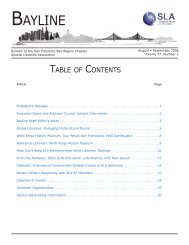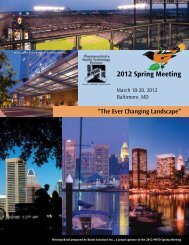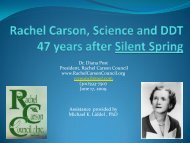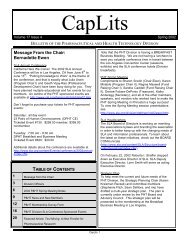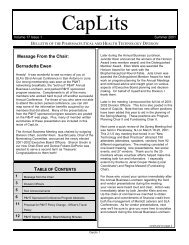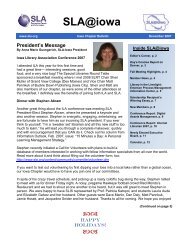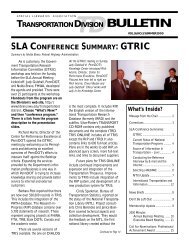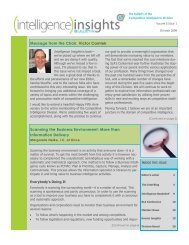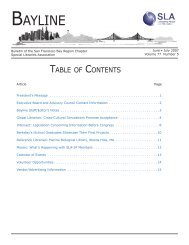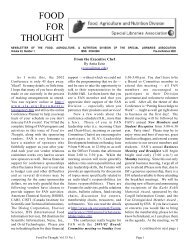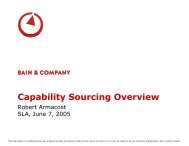Education Libraries - Special Libraries Association
Education Libraries - Special Libraries Association
Education Libraries - Special Libraries Association
Create successful ePaper yourself
Turn your PDF publications into a flip-book with our unique Google optimized e-Paper software.
open seating area center with comfortable chairs at<br />
the entrance of the center. These changes have<br />
increased student use of the area.<br />
Collections are another essential structure.<br />
According to the new mission statement, the<br />
center “promotes excellence in teaching through<br />
the use of quality resources.” In terms of<br />
curricular materials, “quality resources” implies<br />
materials that are currently used in K-12 schools<br />
in the state (where most of EWU’s education<br />
graduates are employed). “Quality” in a<br />
curriculum center’s collection of children’s<br />
literature includes: a range of titles reflecting<br />
current trends (e.g., contemporary subjects and<br />
genres as well as best-selling titles); award<br />
winners; and innovative titles that challenge<br />
thinking about children’s literature. In EWU<br />
<strong>Libraries</strong>’ Curriculum Center, Meyer found some<br />
quality core materials from which to build the<br />
collection.<br />
Meyer performed a<br />
collection analysis that took<br />
advantage of her experience<br />
in various schools, making<br />
special use of the book:<br />
Collection Management for<br />
Youth: Responding to the<br />
Needs of Learners a valuable<br />
resource for developing a<br />
learner-based collection<br />
(Hughes-Hassell & Mancall,<br />
2005). She found a collection that has evolved<br />
over the years, with a median materials’<br />
publication date of approximately 1980. Several<br />
characteristics made the collection seem outdated<br />
and therefore not quality teaching resources:<br />
• The materials looked unappealing, even<br />
the new children's literature books, because<br />
of the practice removing book covers and<br />
replacing colorful packaging with archival<br />
opaque boxes.<br />
• The majority (60%) of the collection were<br />
donations, most of which had been used in<br />
classrooms twenty years ago.<br />
• Classics like Where the Wild Things Are,<br />
Cat in the Hat, and Where the Sidewalk<br />
In general, curriculum centers need<br />
a collection that changes more<br />
rapidly than other areas of an<br />
academic library and thus should<br />
have processes for routine collection<br />
analysis and management<br />
processes in place<br />
Ends were in shabby condition. Other<br />
classics were missing.<br />
The “good bones” of the center’s collection was in<br />
children's literature since funds had been expended<br />
specifically on children’s literature for several<br />
years.<br />
Meyer began an intensive weeding project almost<br />
immediately. She retained the quality resources<br />
and deselected the others, sending historically<br />
interesting children's literature to the regional<br />
collection at the University of Washington. She<br />
began to order pre-bound books to bring the<br />
collection up to date and to fill in gaps; all book<br />
covers were saved until a new policy of retaining<br />
children's literature book covers was adopted. In<br />
general, curriculum centers need a collection that<br />
changes more rapidly than other areas of an<br />
academic library and thus should have processes<br />
for routine collection analysis and management<br />
processes in place (Osa, 2003).<br />
EWU <strong>Libraries</strong> have always<br />
had complete cataloging of<br />
Curriculum Center materials,<br />
an essential structure for<br />
access. The library has been<br />
able to build on this asset by<br />
enhancing catalog records.<br />
For example, classification<br />
tags that indicate age levels<br />
and genre are now routinely<br />
added to records. This enhancement has also<br />
improved access to the collections by providing<br />
links between databases and the library catalog.<br />
These links now appear in Children's Literature<br />
Comprehensive Database, Novelist, and Novelist<br />
K-8, so students can click through to find the<br />
location and availability of the resources in EWU<br />
<strong>Libraries</strong>’ collections and also to search the virtual<br />
catalog of the Orbis Cascade Alliance, the<br />
consortium of academic libraries in Washington<br />
and Oregon.<br />
Resource (Re)Allocation<br />
The ability to allocate resources in alignment with<br />
the Curriculum Center’s purpose and user needs<br />
has been vital in the center’s transformation.<br />
Resource allocation now depends upon the<br />
<strong>Education</strong> <strong>Libraries</strong>, Volume 31, No. 2, Winter 2008 23



